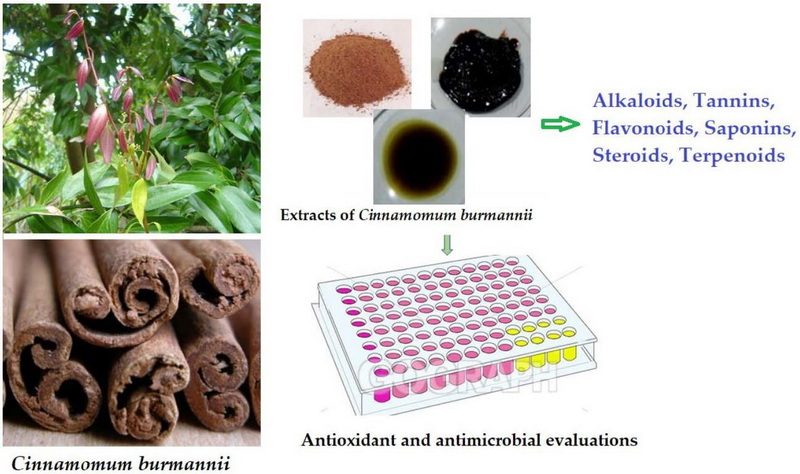Content Menu
● Introduction to Cinnamon Bark Oil Extract
>> Cinnamon Bark Oil Composition
>> Extraction Methods
>>> Steam Distillation
>>> Soxhlet Extraction
● Antioxidant Properties of Cinnamon Bark Oil Extract
>> DPPH Assay
>> Mechanism of Antioxidant Action
● Cinnamon Bark Oil Extract Benefits
>> Culinary Uses
>> Aromatherapy
● Potential Risks and Precautions
● Additional Health Benefits
>> Immune System Support
>> Skin and Hair Care
>> Mood Enhancement
● Cultural and Historical Significance
>> Traditional Medicine
>> Culinary Traditions
● Future Research Directions
>> Clinical Trials
>> Mechanistic Studies
● Conclusion
● FAQs
>> 1. What are the primary components of cinnamon bark oil?
>> 2. How is cinnamon bark oil typically extracted?
>> 3. What are the antioxidant properties of cinnamon bark oil?
>> 4. What are some health benefits of cinnamon bark oil extract?
>> 5. Are there any precautions when using cinnamon bark oil?
● Citations:
Cinnamon bark oil extract, derived from the bark of cinnamon trees, particularly Cinnamomum burmannii and Cinnamomum zeylanicum, has been widely recognized for its diverse health benefits. Among these benefits, its antioxidant properties stand out as a significant aspect of its potential health advantages. This article delves into the antioxidant properties of cinnamon bark oil extract, its extraction methods, and its various benefits.

Introduction to Cinnamon Bark Oil Extract
Cinnamon bark oil is primarily extracted through steam distillation, a method that preserves the integrity of the essential oils without altering their properties. The main components of cinnamon bark oil include cinnamaldehyde, eugenol, and linalool, which collectively contribute to its antioxidant, anti-inflammatory, and antimicrobial properties.
Cinnamon Bark Oil Composition
- Cinnamaldehyde: This compound is the most abundant in cinnamon bark oil, often making up about 60-70% of the oil's composition. It is known for its strong antioxidant activity, capable of neutralizing free radicals such as superoxide anions and hydroxy radicals.
- Eugenol: Present in smaller quantities, eugenol also exhibits antioxidant properties and is known for its analgesic and anti-inflammatory effects.
- Linalool: This compound is less abundant but contributes to the oil's calming and soothing effects.
Extraction Methods
Cinnamon bark oil can be extracted using two primary methods: steam distillation and Soxhlet extraction.
Steam Distillation
This is the most common method for extracting essential oils from cinnamon bark. It involves heating the mashed cinnamon bark with steam, which volatilizes the essential oils. The mixture is then cooled and separated, with the oil settling at the bottom due to its higher density.
Soxhlet Extraction
This method uses a solvent, typically ethanol, to extract the oils. While effective, it requires additional steps to remove the solvent, making it less preferred for essential oil production.
Antioxidant Properties of Cinnamon Bark Oil Extract
The antioxidant activity of cinnamon bark oil is primarily attributed to its ability to scavenge free radicals. Free radicals are unstable molecules that can cause oxidative stress, leading to cell damage and contributing to various diseases. Cinnamon bark oil, particularly through its cinnamaldehyde content, has been shown to effectively neutralize these radicals.
DPPH Assay
The antioxidant activity of cinnamon bark oil is often evaluated using the DPPH (2,2-diphenyl-1-picrylhydrazyl) assay. This test measures the ability of a compound to reduce the purple color of DPPH, indicating its antioxidant capacity. Studies have shown that cinnamon bark oil exhibits a strong antioxidant activity with an IC50 value of less than 50 ppm, indicating its potential as a natural antioxidant.
Mechanism of Antioxidant Action
Cinnamaldehyde, the primary component of cinnamon bark oil, acts as an antioxidant by donating electrons to neutralize free radicals. This process prevents oxidative damage to cells and tissues, potentially reducing the risk of chronic diseases such as cancer, diabetes, and cardiovascular disease.
Cinnamon Bark Oil Extract Benefits
Beyond its antioxidant properties, cinnamon bark oil extract offers a range of health benefits:
- Anti-inflammatory Effects: It helps reduce inflammation, which can alleviate conditions such as arthritis and improve overall health.
- Antimicrobial Properties: Cinnamon bark oil is effective against various bacteria and fungi, making it useful for treating infections.
- Cardiovascular Health: It can help lower blood pressure and cholesterol levels, reducing the risk of heart disease.
- Neuroprotective Effects: Some studies suggest that cinnamon extracts may help in managing neurodegenerative diseases like Alzheimer's and Parkinson's.
- Digestive Health: Cinnamon oil can alleviate digestive issues such as bloating and gas due to its carminative properties.
Culinary Uses
Cinnamon bark oil is also used in cooking and baking due to its warm, sweet flavor. It is a popular ingredient in desserts, beverages, and savory dishes, adding depth and aroma without the need for large quantities of ground cinnamon.
Aromatherapy
In aromatherapy, cinnamon bark oil is used for its invigorating and uplifting effects. It can help improve mood and reduce stress when inhaled.

Potential Risks and Precautions
While cinnamon bark oil offers numerous benefits, it is essential to use it responsibly:
- Skin Irritation: Direct application of cinnamon bark oil to the skin can cause irritation or allergic reactions in some individuals.
- Pregnancy and Breastfeeding: Pregnant or breastfeeding women should consult a healthcare provider before using cinnamon bark oil due to its potential effects on blood sugar levels.
- Allergic Reactions: Some people may be allergic to cinnamon or its components, so it is crucial to perform a patch test before using it extensively.
Additional Health Benefits
Immune System Support
Cinnamon bark oil may help boost the immune system by reducing inflammation and fighting off pathogens. Its antimicrobial properties can aid in preventing infections and supporting overall immune function.
Skin and Hair Care
Cinnamon oil can be used in skincare routines to reduce acne and improve skin tone due to its antibacterial properties. It may also promote hair growth by improving blood circulation to the scalp.
Mood Enhancement
The aroma of cinnamon bark oil can have a positive effect on mood, reducing stress and anxiety. It is often used in aromatherapy to create a calming yet invigorating atmosphere.
Cultural and Historical Significance
Cinnamon has been a prized spice throughout history, used not only for culinary purposes but also for its medicinal and spiritual properties. In ancient civilizations, cinnamon was valued for its ability to preserve food and its perceived health benefits.
Traditional Medicine
In traditional medicine, cinnamon has been used to treat various ailments, from digestive issues to respiratory problems. Its use spans across different cultures, highlighting its versatility and effectiveness.
Culinary Traditions
Cinnamon is an integral part of many cuisines worldwide, particularly in baking and desserts. Its warm flavor adds depth to dishes, making it a staple in both sweet and savory recipes.
Future Research Directions
While cinnamon bark oil has shown promising health benefits, further research is needed to fully understand its effects on human health. Studies focusing on its potential to manage chronic diseases could provide valuable insights into its therapeutic applications.
Clinical Trials
Conducting clinical trials to evaluate the efficacy and safety of cinnamon bark oil in treating specific health conditions would be beneficial. This could lead to its integration into mainstream medicine as a complementary therapy.
Mechanistic Studies
Understanding the molecular mechanisms behind the antioxidant and anti-inflammatory effects of cinnamon bark oil could help in developing targeted therapies for various diseases.
Conclusion
Cinnamon bark oil extract is a rich source of antioxidants, primarily due to its high content of cinnamaldehyde. Its antioxidant properties, combined with anti-inflammatory, antimicrobial, and neuroprotective effects, make it a valuable natural remedy for various health conditions. While it offers numerous benefits, it is essential to use cinnamon bark oil responsibly and in moderation to avoid adverse effects.

FAQs
1. What are the primary components of cinnamon bark oil?
The primary components of cinnamon bark oil are cinnamaldehyde, eugenol, and linalool, which collectively contribute to its health benefits.
2. How is cinnamon bark oil typically extracted?
Cinnamon bark oil is typically extracted using steam distillation, a method that preserves the integrity of the essential oils.
3. What are the antioxidant properties of cinnamon bark oil?
Cinnamon bark oil exhibits strong antioxidant activity, primarily due to its cinnamaldehyde content, which can neutralize free radicals and reduce oxidative stress.
4. What are some health benefits of cinnamon bark oil extract?
Cinnamon bark oil extract offers several health benefits, including anti-inflammatory effects, antimicrobial properties, cardiovascular health support, and potential neuroprotective effects.
5. Are there any precautions when using cinnamon bark oil?
Yes, prolonged exposure to cinnamon oil can cause headaches or nausea in some individuals. It is recommended to start with short sessions to assess tolerance.
Citations:
[1] https://www.scitepress.org/Papers/2022/120258/120258.pdf
[2] https://draxe.com/essential-oils/cinnamon-oil/
[3] http://www.orientjchem.org/vol30no1/extraction-of-essential-oil-from-cinnamon-cinnamomum-zeylanicum/
[4] https://patents.google.com/patent/WO2010041252A2/zh
[5] https://pmc.ncbi.nlm.nih.gov/articles/PMC6268419/
[6] https://www.newdirectionsaromatics.com/blog/cinnamon-leaf-bark-oils-top-benefits-common-uses/
[7] https://aromaenergy.co.uk/blogs/essential-oils/cinnamon-essential-oil-exploring-the-benefits-uses-and-faqs
[8] https://pmc.ncbi.nlm.nih.gov/articles/PMC10433916/






























